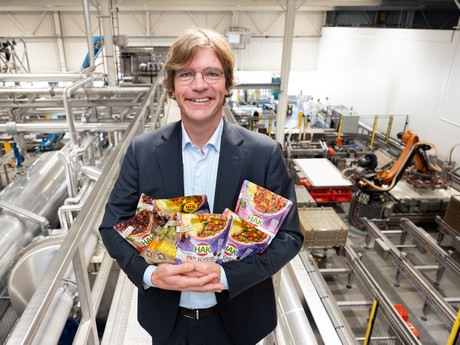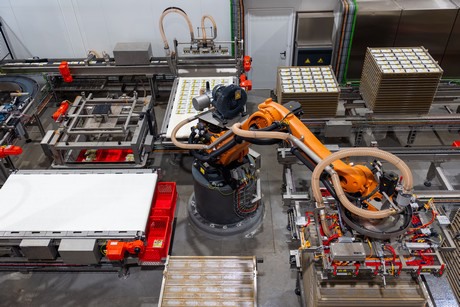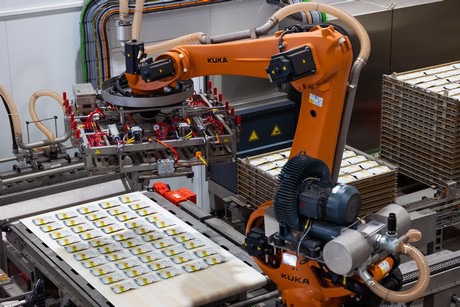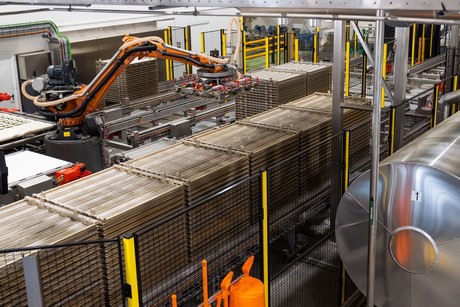The pouches of HAK have become a permanent fixture on supermarket shelves. The vegetable producer from Giessen, Germany, took a new factory with a fully automatic pouch line into use this week. The complete production of pouches has thus come ‘home’ to Giessen.
Food service
In HAK’s existing factory in Giessen, room has been cleared for the new pouch line. “We’ve chosen a fully automatic line and flexibility in packaging,” says CEO Timo Hoogeboom. A test run was started on 1 September. In that period, all products in pouches were produced using the line. The line handles packaging of 100 millilitres (about 100 grammes) to two litres (about 2 kilograms). This also allows HAK to target a new audience, which the vegetable processor gained after the takeover of Peter van Halder in 2017: food service. This market was out of reach because of the restrictions for glass in industrial kitchens.

Timo Hoogeboom, CEO of HAK, with part of the new pouch line in the background.
One-dimensional becomes three-dimensional
“We don’t just want to be the first mover, we also want to become a cost leader in pouches,” Timo says. “That makes it interesting to work with us for the co-creation of products with strategic customers, both within our current segment and outside of it.” The pouch line will also be used for the production of private label. “That’s a different strategy than glass, for which HAK doesn’t produce under private label.”
According to the CEO, HAK is now in a good position to better carry out its mission. “We’ll go from a one-dimensional brand to a three-dimensional brand.” Timo means the broadening the brand experienced from glass jars in supermarkets to consumption any time and anywhere. “A lot of vegetables and legumes are bought out of home, and that concerns cooled products.”
“Everything that’s meant for industrial kitchens in tinned or frozen food, we could supply in pouches,” Timo describes the possibilities. Food service is still the most important market for cooled fresh, and Peter van Halder has a strong position on this market. Besides, the industrial kitchens and catering are a growth market, Timo explains. “Fewer and fewer chefs are seen in kitchens, meals are assembled more. We’re seeing opportunities for growth in that.”
HAK is mostly well-known for their vegetables in glass jars, which are traditionally used as meal component for evening meals. Glass is still an important part of the company, good for 80% of turnover. With the pouches, the company starts on a new market of mostly younger consumers (18 to 35 years old) and the number of uses increases, for the consumer market as well. “Our salad-enrichers and soups are more in keeping with lunch,” Timo says.

Plastic pouches
What about the sustainability of the pouches? “Next year we want to switch to a plastic pouch, which will be recyclable and fit to use in microwaves,” Timo continues. “We once started with these, but we ran into problems regarding the sealing, among other things, of the packaging.” Now that the company has the production completely under their own control, the reintroduction of the plastic pouch becomes possible.
For vegetables in glass, HAK has been working on reducing sugar and salt for years. As of last year, no sugar is added to the summer vegetables. Great strides are also being made for applesauce. Besides the introduction of an applesauce with 0% added sugar, the amount o sugar added was halved for the classic versions. Recipe products, such as red cabbage with apple, beets or baked beans in tomato sauce, each get a version that have 0% added sugar and salt. All new products have no added sugars, a low percentage of added salt and 100% natural ingredients. This is also the case for the majority of the existing assortment, for that matter.

Growth in Germany
The pouches have also been introduced internationally in Germany and Belgium. HAK sees a lot of room to grow particularly in Germany. HAK wants to continue building its market position in Germany with glass and pouches. In the past, the products were mostly available in North Rhine-Westphalia, but after the takeover of Foodeko in 2017, HAK has had all of Germany as a sales region within reach. “The German market is mostly glass and pouches. Taking the pouch line into use is mostly a turning point so that the production and logistics are ready for growth,” Timo explains.
In the coming years, HAK wants to increase its presence in Germany considerably. “The company in Germany is focused on the growth of HAK in glass and pouches. We expect to grow by 20% on that market every year.” Thanks to the national distribution in Germany, the company also expects to grow in products such as applesauce and red cabbage. This year, legumes in pouches were introduced, and as of January, German consumers can also expect pouches with bean dishes on their shelves.

250 innovations per year
“With the factory in Giessen and the location in Den Bosch, we own and are completely in control of three techniques for the supply chain,” Timo says. The division is simple: Giessen for glass and pouches, Den Bosch for cooled fresh. “We from HAK want to make the products we market ourselves. The higher price consumers pay for HAK products should be seen in a better quality of the products.”
With the new machine line, the expansion of HAK will be complete for now. In Den Bosch, investments in production capacity and ‘high care and high risk facilities’ are still being made. The company will continue to invest in the organisation. “We now present 25 innovations per year, that should be about 200,” Timo specifies the ambition. With the company’s facilities, that shouldn’t be a problem. In recent months, various new employees were welcomed who will contribute to realising this ambition.
For more information:
